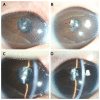Whole-Exome Sequencing and Copy Number Analysis in a Patient with Warburg Micro Syndrome
- PMID: 36553631
- PMCID: PMC9777746
- DOI: 10.3390/genes13122364
Whole-Exome Sequencing and Copy Number Analysis in a Patient with Warburg Micro Syndrome
Abstract
Warburg Micro syndrome (WARBM) is an autosomal recessive neuro-ophthalmologic syndrome characterized by microcephaly, microphthalmia, congenital cataracts, cortical dysplasia, corpus callosum hypoplasia, spasticity, and hypogonadism. WARBM is divided into four subtypes according to the causative genes, of which RAB3GAP1 (OMIM# 602536) accounts for the highest proportion. We collected detailed medical records and performed whole-exome sequencing (WES) for a congenital cataract patient. A novel heterozygous frameshift RAB3GAP1 variant was detected in a boy with a rare ocular phenotype of bilateral membranous cataracts accompanied by a persistent papillary membrane. Further copy number variation (CNV) analysis identified a novel deletion on chromosome 2q21.3 that removed 4 of the 24 exons of RAB3GAP1. The patient was diagnosed with WARBM following genetic testing. The present study expands the genotypic and phenotypic spectrum of WARBM. It suggests applying whole exome sequencing (WES) and CNV analysis for the early diagnosis of syndromic diseases in children with congenital cataracts.
Keywords: RAB3GAP1; Warburg Micro syndrome; copy number variation; early diagnosis.
Conflict of interest statement
The authors declare that the research was conducted in the absence of any commercial or financial relationships that could be construed as a potential conflict of interest.
Figures



References
-
- Bem D., Yoshimura S., Nunes-Bastos R., Bond F.C., Kurian M.A., Rahman F., Handley M.T., Hadzhiev Y., Masood I., Straatman-Iwanowska A.A., et al. Loss-of-function mutations in RAB18 cause Warburg micro syndrome. Am. J. Hum. Genet. 2011;88:499–507. doi: 10.1016/j.ajhg.2011.03.012. - DOI - PMC - PubMed
-
- Liegel R.P., Handley M.T., Ronchetti A., Brown S., Langemeyer L., Linford A., Chang B., Morris-Rosendahl D.J., Carpanini S., Posmyk R., et al. Loss-of-function mutations in TBC1D20 cause cataracts and male infertility in blind sterile mice and Warburg micro syndrome in humans. Am. J. Hum. Genet. 2013;93:1001–1014. doi: 10.1016/j.ajhg.2013.10.011. - DOI - PMC - PubMed
-
- Aligianis I.A., Morgan N.V., Mione M., Johnson C.A., Rosser E., Hennekam R.C., Adams G., Trembath R.C., Pilz D.T., Stoodley N., et al. Mutation in Rab3 GTPase-activating protein (RAB3GAP) noncatalytic subunit in a kindred with Martsolf syndrome. Am. J. Hum. Genet. 2006;78:702–707. doi: 10.1086/502681. - DOI - PMC - PubMed
Publication types
MeSH terms
Substances
Supplementary concepts
LinkOut - more resources
Full Text Sources
Medical

